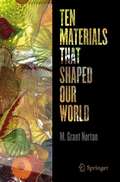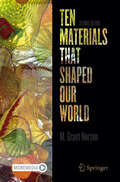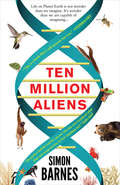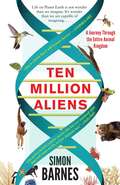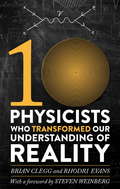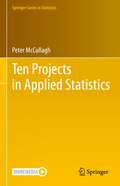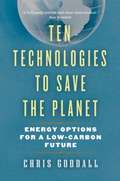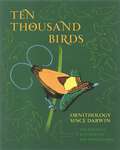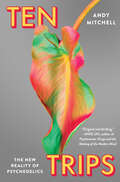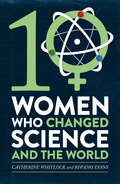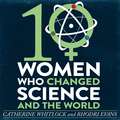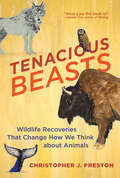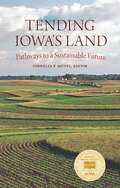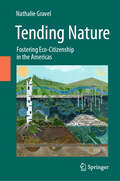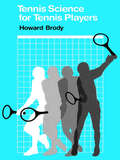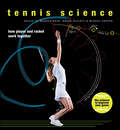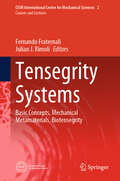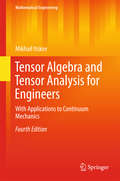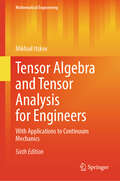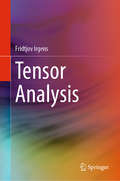- Table View
- List View
Ten Materials That Shaped Our World
by M. Grant NortonThis book examines ten materials—flint, clay, iron, gold, glass, cement, rubber, polyethylene, aluminum, and silicon—explaining how they formed, how we discovered them, why they have the properties they do, and how they have transformed our lives. Since the dawn of the Stone Age, we have shaped materials to meet our needs and, in turn, those materials have shaped us.The fracturing of flint created sharp, curved surfaces that gave our ancestors an evolutionary edge. Molding clay and then baking it in the sun produced a means of recording the written word and exemplified human artistic imagination. As our ability to control heat improved, earthenware became stoneware and eventually porcelain, the most prized ceramic of all. Iron cast at high temperatures formed the components needed for steam engines, locomotives, and power looms—the tools of the Industrial Revolution. Gold has captivated humans for thousands of years and has recently found important uses in biology, medicine, and nanotechnology. Glass shaped into early and imperfect lenses not only revealed the microscopic world of cells and crystals, but also allowed us to discover stars and planets beyond those visible with the naked eye. Silicon revolutionized the computer, propelling us into the Information Age and with it our interconnected social networks, the Internet of Things, and artificial intelligence.Written by a materials scientist, this book explores not just why, but also how certain materials came to be so fundamental to human society. This enlightening study captivates anyone interested in learning more about the history of humankind, our ingenuity, and the materials that have shaped our world.
Ten Materials That Shaped Our World (Copernicus Books)
by M. Grant NortonThis Premium Edition of Ten Materials That Shaped Our World is part of a small audiobook pilot program at Springer Nature. It includes audio files accessible online via the Springer Nature MoreMedia App. This book examines ten materials—flint, clay, iron, gold, glass, cement, rubber, polyethylene, aluminum, and silicon—explaining how they formed, how we discovered them, why they have the properties they do, and how they have transformed our lives. Since the dawn of the Stone Age, we have shaped materials to meet our needs and, in turn, those materials have shaped us. The fracturing of flint created sharp, curved surfaces that gave our ancestors an evolutionary edge. Molding clay and then baking it in the sun produced a means of recording the written word and exemplified human artistic imagination. As our ability to control heat improved, earthenware became stoneware and eventually porcelain, the most prized ceramic of all. Iron cast at high temperatures formed the components needed for steam engines, locomotives, and power looms—the tools of the Industrial Revolution. Gold has captivated humans for thousands of years and has recently found important uses in biology, medicine, and nanotechnology. Glass shaped into early and imperfect lenses not only revealed the microscopic world of cells and crystals, but also allowed us to discover stars and planets beyond those visible with the naked eye. Silicon revolutionized the computer, propelling us into the Information Age and with it our interconnected social networks, the Internet of Things, and artificial intelligence. Written by a materials scientist, this book explores not just why, but also how certain materials came to be so fundamental to human society. This enlightening study captivates anyone interested in learning more about the history of humankind, our ingenuity, and the materials that have shaped our world.
Ten Million Aliens: A Journey Through the Entire Animal Kingdom
by Simon BarnesLife on planet earth is not weirder than we imagine. It"s weirder than we are capable of imagining. In this breathtakingly audacious book, Simon Barnes opens our eyes to the real marvels of the planet we live on.
Ten Million Aliens: A Journey Through the Entire Animal Kingdom
by Simon BarnesFor Discovery Channel enthusiasts, this scientific foray into life on planet earth examines how the world&’s creatures--both weird and wonderful--are inextricably linked.Life on planet earth is not weirder than we imagine. It’s weirder than we are capable of imagining. And we’re all in it together: humans, blue whales, rats, birds of paradise, ridiculous numbers of beetles, molluscs the size of a bus, the sexual gladiators of slugs, bdelloid rotifers who haven’t had sex for millions of years and creatures called water bears: you can boil them, freeze them and fire them off into space without killing them.We’re all part of the animal kingdom, appearing in what Darwin called “endless forms most beautiful and most wonderful." In this breathtakingly audacious book, Simon Barnes has brought us all together, seeking not what separates us but what unites us. He takes us white-water rafting through the entire animal kingdom in a book that brings in deep layers of arcane knowledge, the works of Darwin and James Joyce, Barnes’s own don’t-try-this-at-home adventures in the wild, David Attenborough and Sherlock Holmes. Ten Million Aliens opens your eyes to the real marvels of the planet we live on.
Ten Physicists who Transformed our Understanding of Reality
by Rhodri Evans Brian CleggAcclaimed popular-science writer Brian Clegg and popular TV and radio astronomer Rhodri Evans give us a Top Ten list of physicists as the central theme to build an exploration of the most exciting breakthroughs in physics, looking not just at the science, but also the fascinating lives of the scientists themselves. The Top Ten are: 1.Isaac Newton (1642-1727)2.Niels Bohr (1885-1962)3.Galileo Galilei (1564-1642)4.Albert Einstein (1879-1955)5.James Clerk Maxwell (1831-1879)6.Michael Faraday (1791-1867)7.Marie Curie (1867-1934)8.Richard Feynman (1918-1988)9.Ernest Rutherford (1871-1937)10.Paul Dirac (1902-1984)Each of these figures has made a huge contribution to physics. Some are household names, others more of a mystery, but in each case there is an opportunity to combine a better understanding of the way that each of them has advanced our knowledge of the universe with an exploration of their often unusual, always interesting lives. Whether we are with Curie, patiently sorting through tons of pitchblende to isolate radium or feeling Bohr's frustration as once again Einstein attempts to undermine quantum theory, the combination of science and biography humanizes these great figures of history and makes the Physics itself more accessible.In exploring the way the list has been built the authors also put physics in its place amongst the sciences and show how it combines an exploration of the deepest and most profound questions about life and the universe with practical applications that have transformed our lives. The book is structured chronologically, allowing readers to follow the development of scientific knowledge over more than 400 years, showing clearly how this key group of individuals has fundamentally altered our understanding of the world around us.
Ten Projects in Applied Statistics (Springer Series in Statistics)
by Peter McCullaghThe first half of the book is aimed at quantitative research workers in biology, medicine, ecology and genetics. The book as a whole is aimed at graduate students in statistics, biostatistics, and other quantitative disciplines. Ten detailed examples show how the author approaches real-world statistical problems in a principled way that allows for adequate compromise and flexibility. The need to accommodate correlations associated with space, time and other relationships is a recurring theme, so variance-components models feature prominently. Statistical pitfalls are illustrated via examples taken from the recent scientific literature. Chapter 11 sets the scene, not just for the second half of the book, but for the book as a whole. It begins by defining fundamental concepts such as baseline, observational unit, experimental unit, covariates and relationships, randomization, treatment assignment, and the role that these play in model formulation. Compatibility of the model with the randomization scheme is crucial. The effect of treatment is invariably modelled as a group action on probability distributions. Technical matters connected with space-time covariance functions, residual likelihood, likelihood ratios, and transformations are discussed in later chapters.
Ten Technologies to Save the Planet
by Chris GoodallRespected, authoritative, award-winning author Chris Goodall tackles global warming reversal in this engaging and balanced book. Ten Technologies to Save the Planet - popular science writing at its most crucial - is arguably the most readable and comprehensive overview of large-scale solutions to climate change available. Goodall profiles ten technologies with the potential to slash global greenhouse emissions, explaining how they work and telling the stories of the inventors, scientists, and entrepreneurs who are driving them forward. Some of Goodall's selections, such as the electric car, are familiar. Others, like algae and charcoal, are more surprising. Illustrated with black-and-white photos and simple charts, Ten Technologies to Save the Planet combines cutting-edge analysis with straightforward explanations about pros and cons, and debunks myths along the way.
Ten Thousand Birds: Ornithology since Darwin
by Tim Birkhead Bob Montgomerie Jo WimpennyTen Thousand Birds provides a thoroughly engaging and authoritative history of modern ornithology, tracing how the study of birds has been shaped by a succession of visionary and often-controversial personalities, and by the unique social and scientific contexts in which these extraordinary individuals worked. This beautifully illustrated book opens in the middle of the nineteenth century when ornithology was a museum-based discipline focused almost exclusively on the anatomy, taxonomy, and classification of dead birds. It describes how in the early 1900s pioneering individuals such as Erwin Stresemann, Ernst Mayr, and Julian Huxley recognized the importance of studying live birds in the field, and how this shift thrust ornithology into the mainstream of the biological sciences. The book tells the stories of eccentrics like Colonel Richard Meinertzhagen, a pathological liar who stole specimens from museums and quite likely murdered his wife, and describes the breathtaking insights and discoveries of ambitious and influential figures such as David Lack, Niko Tinbergen, Robert MacArthur, and others who through their studies of birds transformed entire fields of biology. Ten Thousand Birds brings this history vividly to life through the work and achievements of those who advanced the field. Drawing on a wealth of archival material and in-depth interviews, this fascinating book reveals how research on birds has contributed more to our understanding of animal biology than the study of just about any other group of organisms.
Ten Trips: The New Reality of Psychedelics
by Andy MitchellThe more we learn about psychedelics, the less we seem to understand them. . . . In this engrossing, sometimes hilarious, always dramatic chronicle, a neuropsychologist deflates the hype, explores the limitless possibilities, and reveals a much-needed perspective about psychedelics, giving us a scientist’s first-person experiment with ten different compounds in ten different settings. Once demonized and still largely illegal, psychedelic drugs are now officially a “breakthrough therapy” in treating mental illness, used to heal trauma, conquer addiction, and enhance well-being. But as Andy Mitchell reveals, this approach to psychedelics is overhyped, and most importantly, neglects what is so unusual and valuable about them: the psychedelic experience itself.In Ten Trips, Mitchell takes ten different drugs in ten diverse locations—including a neuroimaging lab in London, the Columbian Andes, Silicon Valley and his friend’s basement kitchen—to document their remarkable effects. Along the way he encounters a cast of distinctive characters: scientists and gangsters, venture capitalists and philosophers, psychonauts and shamans, musicians, monks, therapists, poets, and conmen. His experience opens a doorway to psychedelics’ full potential: for healing and trauma, for ecstatic one-ness and utter terror, for transcendence and corruption, for profundity and laughter.Mitchell argues that by removing psychedelics from their cultures and rituals, both indigenous and underground, we risk rejecting the expertise and the contexts which hold the key to understanding them—and from which their real benefits may derive. In the drive to standardize, control, and monetize the psychedelic experience, we may ultimately destroy what makes them potent: their ability to transform our whole perspective on mental health and reenchant us with the world.A hallucinogenic experience nearly as mind-blowing as actually taking psychedelics themselves, Ten Trips is Michael Pollan’s How to Change Your Mind written by Hunter S. Thompson with a PhD in neuroscience—a perception-altering odyssey that will change the way we see these substances and the world.
Ten Women Who Changed Science, and the World
by Rhodri Evans Catherine Whitlock'These minibiographies of women who persisted will move anyone with an avid curiosity about the world.' Publishers Weekly With a foreword by Athene Donald, Professor of Experimental Physics, University of Cambridge and Master of Churchill College.Ten Women Who Changed Science tells the moving stories of the physicists, biologists, chemists, astronomers and doctors who helped to shape our world with their extraordinary breakthroughs and inventions, and outlines their remarkable achievements.These scientists overcame significant obstacles, often simply because they were women. Their science and their lives were driven by personal tragedies and shaped by seismic world events. What drove these remarkable women to cure previously incurable diseases, disprove existing theories or discover new sources of energy? Some were rewarded with the Nobel Prize for their pioneering achievements -Madame Curie, twice - others were not and, even if they had been, many are still not the household names they should be.Despite living during periods when the contribution of women was disregarded, if not ignored, these resilient women persevered with their research, whether creating life-saving drugs or expanding our knowledge of the cosmos. By daring to ask 'How?' and 'Why?' and persevering against all odds, each of these women, in a variety of ways, has helped to make the world a better place.The scientists are: Henrietta Leavitt (United States, Astronomy); Lise Meitner (Austria, Physics); Chien-Shiung Wu (United States, Physics); Marie Curie (France, Chemistry); Dorothy Crowfoot Hodgkin (United Kingdom, Chemistry); Virginia Apgar (United States, Medicine); Gertrude Elion (United States, Medicine); Rita Levi-Montalicini (Italy, Biology); Elsie Widdowson (United Kingdom, Biology); Rachel Carson (United States, Biology).
Ten Women Who Changed Science, and the World
by Rhodri Evans Catherine Whitlock'These minibiographies of women who persisted will move anyone with an avid curiosity about the world.' Publishers Weekly With a foreword by Athene Donald, Professor of Experimental Physics, University of Cambridge and Master of Churchill College.Ten Women Who Changed Science tells the moving stories of the physicists, biologists, chemists, astronomers and doctors who helped to shape our world with their extraordinary breakthroughs and inventions, and outlines their remarkable achievements.These scientists overcame significant obstacles, often simply because they were women. Their science and their lives were driven by personal tragedies and shaped by seismic world events. What drove these remarkable women to cure previously incurable diseases, disprove existing theories or discover new sources of energy? Some were rewarded with the Nobel Prize for their pioneering achievements -Madame Curie, twice - others were not and, even if they had been, many are still not the household names they should be.Despite living during periods when the contribution of women was disregarded, if not ignored, these resilient women persevered with their research, whether creating life-saving drugs or expanding our knowledge of the cosmos. By daring to ask 'How?' and 'Why?' and persevering against all odds, each of these women, in a variety of ways, has helped to make the world a better place.The scientists are: Henrietta Leavitt (United States, Astronomy); Lise Meitner (Austria, Physics); Chien-Shiung Wu (United States, Physics); Marie Curie (France, Chemistry); Dorothy Crowfoot Hodgkin (United Kingdom, Chemistry); Virginia Apgar (United States, Medicine); Gertrude Elion (United States, Medicine); Rita Levi-Montalicini (Italy, Biology); Elsie Widdowson (United Kingdom, Biology); Rachel Carson (United States, Biology).
Ten Women Who Changed Science, and the World
by Rhodri Evans Catherine Whitlock'These minibiographies of women who persisted will move anyone with an avid curiosity about the world.' Publishers Weekly With a foreword by Athene Donald, Professor of Experimental Physics, University of Cambridge and Master of Churchill College.Ten Women Who Changed Science tells the moving stories of the physicists, biologists, chemists, astronomers and doctors who helped to shape our world with their extraordinary breakthroughs and inventions, and outlines their remarkable achievements.These scientists overcame significant obstacles, often simply because they were women. Their science and their lives were driven by personal tragedies and shaped by seismic world events. What drove these remarkable women to cure previously incurable diseases, disprove existing theories or discover new sources of energy? Some were rewarded with the Nobel Prize for their pioneering achievements -Madame Curie, twice - others were not and, even if they had been, many are still not the household names they should be.Despite living during periods when the contribution of women was disregarded, if not ignored, these resilient women persevered with their research, whether creating life-saving drugs or expanding our knowledge of the cosmos. By daring to ask 'How?' and 'Why?' and persevering against all odds, each of these women, in a variety of ways, has helped to make the world a better place.The scientists are: Henrietta Leavitt (United States, Astronomy); Lise Meitner (Austria, Physics); Chien-Shiung Wu (United States, Physics); Marie Curie (France, Chemistry); Dorothy Crowfoot Hodgkin (United Kingdom, Chemistry); Virginia Apgar (United States, Medicine); Gertrude Elion (United States, Medicine); Rita Levi-Montalicini (Italy, Biology); Elsie Widdowson (United Kingdom, Biology); Rachel Carson (United States, Biology).
Ten Years of Progress in GW/P Body Research
by Edward K. Chan Marvin J. FritzlerGW bodies are novel cytoplasmic foci that were discovered and named by Dr. Chan's group in 2002. These bodies are now known to be active cytoplasmic foci involved with the new gene regulation process mediated by microRNA that leads to translational repression and mRNA degradation. The detailed biological functions of these cytoplasmic structures are still being uncovered and the idea for this book is to provide the history of the discovery and the major work from different laboratories that has led to the characterization and elucidation of the structure and function of these new multiple subcellular structures.
Tenacious Beasts: Wildlife Recoveries That Change How We Think about Animals
by Christopher J. PrestonAn inspiring look at wildlife species that are defying the odds and teaching important lessons about how to share a planet.The news about wildlife is dire—more than 900 species have been wiped off the planet since industrialization. Against this bleak backdrop, however, there are also glimmers of hope and crucial lessons to be learned from animals that have defied global trends toward extinction. Bear in Italy, bison in North America, whales in the Atlantic. These populations are back from the brink, some of them in numbers unimaginable in a century. How has this happened? What shifts in thinking did it demand? In crisp, transporting prose, Christopher Preston reveals the mysteries and challenges at the heart of these resurgences.Drawing on compelling personal stories from the researchers, Indigenous people, and activists who know the creatures best, Preston weaves together a gripping narrative of how some species are taking back vital, ecological roles. Each section of the book—farms, prairies, rivers, forests, oceans—offers a philosophical shift in how humans ought to think about animals, passionately advocating for the changes in attitude necessary for wildlife recovery.Tenacious Beasts is quintessential nature writing for the Anthropocene, touching on different facets of ecological restoration from Indigenous knowledge to rewilding practices. More important, perhaps, the book offers a road map—and a measure of hope—for a future in which humans and animals can once again coexist.
Tending Iowa's Land
by Cornelia F. MutelIn this collection of essays, Iowa serves as a microcosm for the perils facing the environment today and strategies for restoring the land. Cornelia Mutel introduces each section with a personal essay, sharing her love for the land, her deep concern over environmental losses, and hope for a healthier future. In each section —Soil, Water, Air, and Life—a variety of authors contribute their personal reflections and scientific knowledge. Although the book recognizes devastating losses, the tone remains hopeful.
Tending Nature: Fostering Eco-Citizenship in the Americas
by Nathalie GravelThis book aims to enhance understanding of the foundational principles and ethical considerations of citizen engagement in environmental conservation through an examination of successful cases of shared environmental governance in the Americas. It seeks to inform policymaking on strategies for fostering behavioral change and advancing towards co-management of national public resources and the commons. These cases are analyzed through a geographical lens to provide a framework for reimagining eco-citizenship grounded in bioregionalism. This perspective diverges from the notion of eco-citizenship as a universal culture, advocating instead for its integration within the collective habitats of citizen groups. Readers will gain insights into fostering reconciliation between nature and humanity by empowering diverse stakeholders to lead Blue/Green/Bee conservation initiatives. Emphasizing community learning, environmental awareness, and citizen participation, the book enriches decision-making processes and promotes environmental justice for all living organisms. The selected case studies from Brazil, Canada, Costa Rica, Mexico, and the United States highlight pioneering innovations in Blue/Green/Bee policy planning across urban, periurban, and rural settings. These initiatives propose empathetic and respectful approaches to nurturing our natural surroundings, including methods for co-management, networked urban gardening, wild native bee conservation, water source protection, community-based water management, river revitalization, and metropolitan green space stewardship. This book will be invaluable to students, urban and rural planners, researchers, academics, networking professionals, policymakers, international development practitioners, environmental organization personnel, and enthusiasts of the natural world alike.
Tennessee Science (Grade #8)
by Daniel Rillero BiggsA science book that interactively involves the students in the learning process in each unit; as it contains a standard list of scientific concepts and activities to do. The major content of the book is * Inquiry * Technology and Engineering * Life Science * Earth Science * Chemistry * Physical Science
Tennessee Science: A Closer Look [Grade 4]
by Dinah Zike Jay K. Hackett Richard H. Moyer Joanne Vasquez Mulugheta Teferi Kathryn Leroy Dorothy J. T. Terman Gerald F. WheelerNIMAC-sourced textbook
Tennessee Science: A Closer Look [Grade 5]
by Dinah Zike Jay K. Hackett Richard H. Moyer Joanne Vasquez Mulugheta Teferi Kathryn Leroy Dorothy J. T. Terman Gerald F. WheelerNIMAC-sourced textbook
Tennis Science for Tennis Players
by Howard BrodyHow does your opponent put that tricky spin on the ball? Why are some serves easier to return than others? The mysteries behind the winning strokes, equipment, and surfaces of the game of tennis are accessibly explained by Howard Brody through the laws of physics. And he gives practical pointers to ways players can use this understanding to advantage in the game.Through extensive laboratory testing and computer modeling, Brody has investigated the physics behind the shape of the tennis racket, the string pattern, the bounce of the tennis ball, the ways a particular court surface can determine the speed of the game, and the many other physical factors involved in tennis.
Tennis Science: How Player and Racquet Work Together
by Bruce Elliott Machar Reid Miguel CrespoIf you have watched a Grand Slam tennis tournament in the past decade, you are probably aware that the game is dominated by just a few international powerhouses. At the conclusion of each tournament, it is likely that you will see Serena Williams atop the women's podium and a member of the Big Four--Roger Federer, Rafael Nadal, Novak Djokovic, and Andy Murray--hoisting the trophy for the men. And while there is not a lot of variety in the outcome of these matches, the game of tennis itself has changed drastically over the decades, as developments in technology and conditioning regimens, among other factors, have altered the style of play. Underpinning many of these developments is science, and this book explains the scientific wonders that take the ball from racquet to racquet and back again. Each chapter explores a different facet of the game--learning, technique, game analysis, the mental edge, physical development, nutrition for performance and recovery, staying healthy, and equipment--and is organized around a series of questions. How do we learn the ins and outs of hitting the ball in and not out? What are the main technological developments and software programs that can be used to assist in performance and notational analysis in tennis? What role does sports psychology play in developing a tennis player? What is the role of fluid replacement for the recreational, junior, and professional player? What rule changes have been made with respect to the racquet, ball, and ball-court interaction to maintain the integrity of the game in the face of technological change? Each question is examined with the aid of explanatory diagrams and illustrations, and the book can be used to search for particular topics, or read straight through for a comprehensive overview of how player and equipment work together. Whether you prefer the grass courts of Wimbledon, the clay courts of the French Open, or the hard courts of the US and Australian Opens, Tennis Science is a must-have for anyone interested in the science behind a winning game.
Tensegrity Systems: Basic Concepts, Mechanical Metamaterials, Biotensegrity (CISM International Centre for Mechanical Sciences #2)
by Fernando Fraternali Julian J. RimoliThis book illustrates the unique mechanical behaviors of tensegrity systems and their applications in mechanical metamaterials, space structures, and biomechanical models. It demonstrates that by controlling the mechanical response of tensegrity structures through internal and external prestress, it is possible to adjust the speed of mechanical waves within these systems, creating tunable bandgap structures. Furthermore, the geometrically nonlinear response exhibited by several tensegrity systems allows for the support of either compression or rarefaction solitary wave dynamics. These behaviors can be effectively utilized to design novel devices capable of focusing mechanical waves in narrow regions of space, as well as innovative impact protection systems. After an introduction to the basic concepts and calculation methods for tensegrity systems and their minimal-mass design, the chapters explore the metamaterial behaviors of tensegrity systems associated with bandgap and solitary wave dynamics; present a mechanical model of flexible tensegrities, illustrating how harnessing the buckling of bars in such systems can result in structures with exceptional energy absorption capabilities, suitable for applications such as planetary landers or lattice metamaterials; and discuss the extreme mechanical behaviors achievable in tensegrity-inspired lattice structures exhibiting both soft and stiff deformation modes. The last chapters address the multifaceted field of biotensegrity, and provide an overview of current rapid prototyping techniques for tensegrity systems, along with a discussion of open questions and research opportunities in the field.
Tensor Algebra and Tensor Analysis for Engineers
by Mikhail ItskovThere is a large gap between the engineering course in tensor algebra on the one hand and the treatment of linear transformations within classical linear algebra on the other hand. The aim of this modern textbook is to bridge this gap by means of the consequent and fundamental exposition. The book primarily addresses engineering students with some initial knowledge of matrix algebra. Thereby the mathematical formalism is applied as far as it is absolutely necessary. Numerous exercises are provided in the book and are accompanied by solutions, enabling self-study. The last chapters of the book deal with modern developments in the theory of isotropic and anisotropic tensor functions and their applications to continuum mechanics and are therefore of high interest for PhD-students and scientists working in this area. This third edition is completed by a number of additional figures, examples and exercises. The text and formulae have been revised and improved where necessary.
Tensor Algebra and Tensor Analysis for Engineers: With Applications to Continuum Mechanics (Mathematical Engineering)
by Mikhail ItskovThis is the sixth and revised edition of a well-received textbook that aims at bridging the gap between the engineering course of tensor algebra on the one hand and the mathematical course of classical linear algebra on the other hand. In accordance with the contemporary way of scientific publication, a modern absolute tensor notation is preferred throughout. The book provides a comprehensible exposition of the fundamental mathematical concepts of tensor calculus and enriches the presented material with many illustrative examples. In particular, the book discusses such multi-physical topics of solid mechanics as electro- and magnetoelasticity. In addition, advanced chapters dealing with recent developments in the theory of isotropic and anisotropic tensor functions and their applications to continuum mechanics are included. This new edition also focuses on numerical aspects of tensor calculus and shows how modern methods of machine learning can be applied to the calculation of tensor functions. Hence, these textbook addresses graduate students as well as scientists working in this field and in particular dealing with interdisciplinary problems. In each chapter numerous exercises are included, allowing for self-study and intense practice. Solutions to the exercises are also provided.
Tensor Analysis
by Fridtjov IrgensThis book presents tensors and tensor analysis as primary mathematical tools for engineering and engineering science students and researchers. The discussion is based on the concepts of vectors and vector analysis in three-dimensional Euclidean space, and although it takes the subject matter to an advanced level, the book starts with elementary geometrical vector algebra so that it is suitable as a first introduction to tensors and tensor analysis. Each chapter includes a number of problems for readers to solve, and solutions are provided in an Appendix at the end of the text. Chapter 1 introduces the necessary mathematical foundations for the chapters that follow, while Chapter 2 presents the equations of motions for bodies of continuous material. Chapter 3 offers a general definition of tensors and tensor fields in three-dimensional Euclidean space. Chapter 4 discusses a new family of tensors related to the deformation of continuous material. Chapter 5 then addresses constitutive equations for elastic materials and viscous fluids, which are presented as tensor equations relating the tensor concept of stress to the tensors describing deformation, rate of deformation and rotation. Chapter 6 investigates general coordinate systems in three-dimensional Euclidean space and Chapter 7 shows how the tensor equations discussed in chapters 4 and 5 are presented in general coordinates. Chapter 8 describes surface geometry in three-dimensional Euclidean space, Chapter 9 includes the most common integral theorems in two- and three-dimensional Euclidean space applied in continuum mechanics and mathematical physics.
